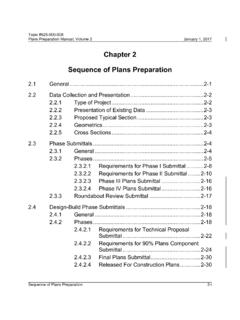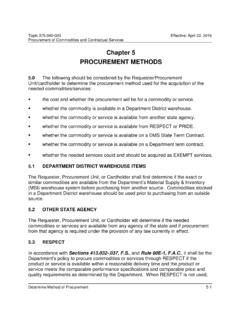Transcription of DRAINAGE MANUAL
1 STATE OF FLORIDA DEPARTMENT OF TRANSPORTATION DRAINAGE MANUAL OFFICE OF DESIGN, DRAINAGE SECTION JANUARY 2016 TALLAHASSEE, FLORIDAT opic No. 625-040- 002 Effective: January 2016 DRAINAGE MANUAL 1 TABLE OF CONTENTS chapter 1 Introduction .. 4 Purpose .. 4 Authority .. 4 Scope .. 4 General .. 4 Documentation of DRAINAGE Design .. 5 Appendices .. 5 Distribution .. 6 Procedure for Revisions and Updates .. 6 Training .. 6 Forms Access .. 6 chapter 2 Open Channel .. 7 Introduction .. 7 Design Frequency .. 7 Hydrologic Analysis .. 7 Hydraulic Analysis .. 8 Manning's "n" Values .. 8 Slope .. 8 Channel Linings and Velocity .. 8 Limitations on Use of Linings .. 9 Channel Bottom .. 10 Channel Freeboard .. 10 Construction and Maintenance Considerations .. 10 Safety .. 11 Protective Treatment .. 11 Roadside Safety .. 11 Documentation.
2 11 chapter 3 Storm Drain Hydrology and Hydraulics .. 15 Introduction .. 15 Pipe Materials .. 15 Design Frequency .. 15 Design Tailwater .. 16 Sea Level Rise .. 17 Hydrologic Analysis .. 20 1 Time of Concentration .. 20 Hydraulic Analysis .. 20 Pipe Slopes .. 20 Hydraulic Gradient .. 20 Outlet Velocity .. 21 Topic No. 625-040- 002 Effective: January 2016 DRAINAGE MANUAL 2 Manning's Roughness Coefficients .. 21 Hydraulic Openings and Protective Treatment .. 22 Entrance Location and Spacing .. 24 Manholes .. 25 Shoulder Gutter .. 25 Inlet Placement .. 26 Grades .. 30 Longitudinal Gutter Grade .. 30 Spread Standards .. 30 Spread for Permanent Construction .. 30 Spread for Temporary Construction .. 30 Construction and Maintenance Considerations .. 31 Pipe Size and Length .. 31 Minimum Clearances .. 32 Pipe Joint Designs Greater than 5 psi .. 33 Pipes within or Adjacent to Retained Earth (Walled) Embankment Sections.
3 34 Additional Design Considerations .. 34 Noise Walls .. 34 French Drains .. 34 Resilient Connectors .. 35 Documentation .. 36 Tabulation Form .. 36 Other Documentation .. 36 chapter 4 Cross Drain Hydraulics .. 38 Introduction .. 38 General .. 38 LRFD Design Code Bridge Design 39 Design Frequency .. 39 Permanent Facilities .. 39 Temporary Facilities .. 39 Backwater .. 40 Tailwater .. 40 Clearances .. 41 Hydrologic Analysis .. 41 Freshwater Flow .. 41 Tidal Flow .. 41 Hydraulic Analysis .. 42 Riverine Crossings .. 42 Tidal Crossings .. 42 Specific Standards Relating to Bridges .. 43 Berms for Spill-Through Abutment Bridges .. 43 Topic No. 625-040- 002 Effective: January 2016 DRAINAGE MANUAL 3 Scour Estimates .. 43 Scour Protection Considerations .. 46 Bridge Deck DRAINAGE .. 48 Wave and Current Forces on Coastal Bridges .. 48 Specific Standards relating to all Cross Drains except Bridges.
4 49 Culvert Materials .. 49 Manning s Roughness Coefficients .. 49 End Treatment .. 50 Construction and Maintenance Considerations .. 50 Documentation .. 51 Culverts (all culverts less than a 20' bridge culvert) .. 51 Bridges .. 52 Document Processing .. 55 chapter 5 Stormwater Management .. 56 Introduction .. 56 Regulatory Requirements .. 56 chapter 14-86, Florida Administrative Code .. 56 Section , Florida Statutes .. 56 chapter 62-25, Florida Administrative Code .. 56 chapter 62-40, Florida Administrative Code .. 56 National Pollutant Discharge Elimination System .. 57 Environmental Look Arounds (ELA) .. 57 Design Standards .. 58 Design of Systems .. 58 Hydrologic Methods .. 60 Protective Treatment .. 60 Construction and Maintenance Considerations .. 60 Documentation .. 63 chapter 6 Optional Culvert Materials .. 65 Introduction .. 65 Durability .. 65 Culvert Service Life Estimation.
5 66 Structural Evaluation .. 66 Hydraulic Evaluations .. 66 Culvert Material Types .. 67 Jack and Bore .. 68 Documentation .. 68 Appendix A DRAINAGE Law .. 71 Appendix B Acquisition of Real Property Rights .. 87 Appendix C Cover Height Tables .. 91 Appendix D Pipes within Walled Embankment Sections .. 111 Topic No. 625-040- 002 Effective: January 2016 DRAINAGE MANUAL 4 chapter 1 Introduction Purpose The DRAINAGE MANUAL sets forth DRAINAGE design standards for Florida Department of Transportation (FDOT) projects. Authority chapter 334, Florida Statute ( ) Sections (4)(a) and (3), Florida Statutes ( ) Scope The principal users of this MANUAL are consultants and FDOT personnel who prepare FDOT construction plans. General chapter 334, , known as the Florida Transportation Code, establishes the responsibilities of the State, counties, and municipalities for the planning and development of the transportation systems serving the people of Florida, with the objective of assuring development of an integrated, balanced statewide system.
6 The Code's purpose is to protect the safety and general welfare of the people of the State and to preserve and improve all transportation facilities in Florida. Under Section , , the Code sets forth the powers and duties of the Department of Transportation to develop and adopt uniform minimum standards and criteria for the design, construction, maintenance, and operation of public roads. The standards in this MANUAL provide a basis for uniform design practice for typical roadway DRAINAGE design situations. Realizing that DRAINAGE design is primarily a matter of sound application of good engineering judgment, it is impossible to give precise rules which would apply to all possible situations that may arise. Situations will exist where these standards will not apply. THE INAPPROPRIATE USE OF AND/OR ADHERENCE TO THESE STANDARDS DOES NOT EXEMPT THE ENGINEER FROM THE PROFESSIONAL RESPONSIBILITY OF DEVELOPING AN APPROPRIATE DESIGN.
7 The engineer is responsible for identifying those standards that do not apply to a particular design, and to obtain approval to deviate from those standards. Deviation from a standard in this MANUAL must be approved by the District DRAINAGE Engineer. The request for Topic No. 625-040- 002 Effective: January 2016 DRAINAGE MANUAL 5 deviation shall include the engineering justification. 23 CFR 650A ( ) prescribes the Federal Highway Administration (FHWA) policies and procedures for the location and hydraulic design of highway encroachments on flood plains. While the standards presented in the FDOT DRAINAGE MANUAL conform to Federal requirements, DRAINAGE designers are advised to become familiar with 23 CFR 650A to develop a basic understanding of some of the design standards for cross drains and bridges. Statistical rainfall depth data for Florida is found in NOAA Atlas 14 Rainfall Data.
8 This data is available at FDOT Rainfall distributions and intensity-duration-frequency curves may be found at Documentation of DRAINAGE Design Approvals of deviation from the MANUAL shall be included in the project DRAINAGE design documentation along with supporting justifications. The hydraulic designer shall provide the Department a signed and sealed DRAINAGE Design Report that addresses the entire project design. It shall be a record set of all DRAINAGE computations, both hydrologic and hydraulic and shall include all necessary support data. The DRAINAGE Design Report shall include, at a minimum, pond routing calculations in ICPR or equivalent software, with justifications of all tailwater stages utilized, a clear description of the overall stormwater management system, storm drain tabulations in Department format, pond recovery calculations, hydraulic spread calculations, special gutter grade calculations, DRAINAGE structure and liner flotation calculations, ditch conveyance calculations, a node-reach diagram superimposed on Department DRAINAGE maps, skimmer calculations, cross drain calculations and other calculations relative to DRAINAGE .
9 Modification for Non-conventional Projects: The hydraulic designer shall provide the Department a DRAINAGE Design Report to accompany all phase submittals (which shall be signed and sealed at the Final Phase submittal) that addresses the entire project design. Appendices Included with this MANUAL are four appendices: Appendix A contains a general overview of DRAINAGE law with discussion of case histories in F lorida. It is provided as an appendix rather than a chapter since it is primarily informational and does not constitute a standard. Topic No. 625-040- 002 Effective: January 2016 DRAINAGE MANUAL 6 Appendix B contains guidance on general FDOT practice with regard to acquisition of DRAINAGE easements, flood rights, etc. Appendix C contains minimum and maximum cover heights for design. Appendix D contains policy on the selection of pipes in proximity to structural walls. Distribution This MANUAL is available for downloading from the website below: Procedure for Revisions and Updates Comments and suggestions for changes to the MANUAL are invited to be submitted by e -mailing the State DRAINAGE Engineer.
10 Appropriate Roadway Design or DRAINAGE Design staff will review each idea or suggestion received in a timely manner. Statewide meetings of the District DRAINAGE Engineers and the State DRAINAGE Engineer are held at least annually and teleconferences are held monthly. A major agenda item at these meetings will be the review of planned revisions, and suggestions and comments that may warrant revisions. Based on input from these meetings, official proposed revisions are developed. The State DRAINAGE Engineer will coordinate the proposed revisions with all the affected offices and with FHWA. Official adoption of the proposed revisions is made by State DRAINAGE Engineer with input from the District DRAINAGE Engineers. Prior to release, all revisions will be coordinated with the Forms and Procedures Office to ensure conformance with and incorporation into the Department s Standard Operating System.









